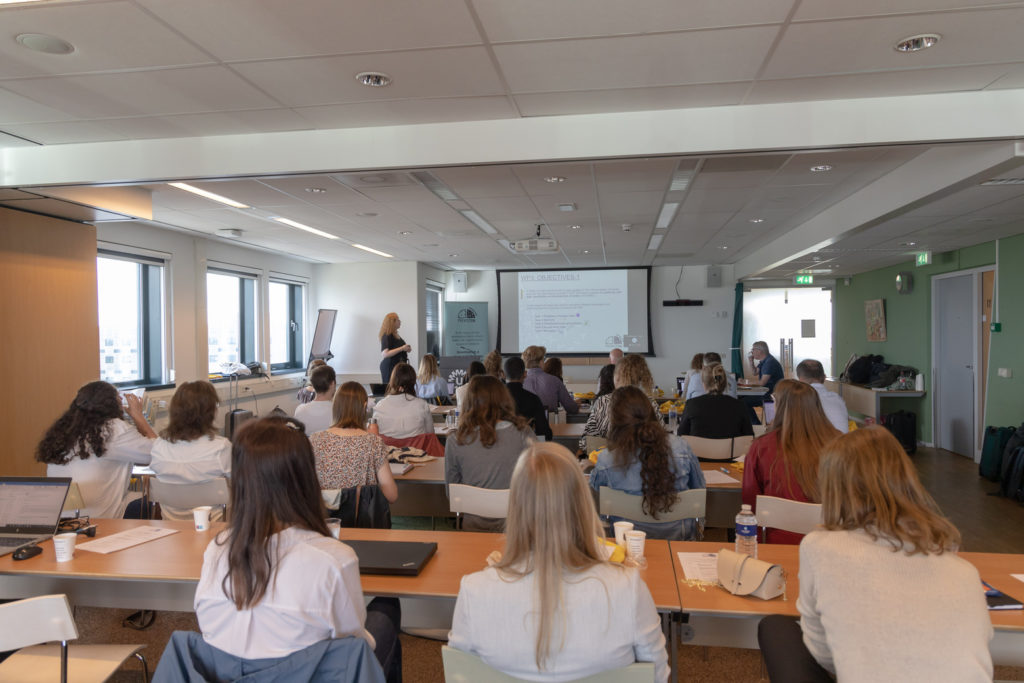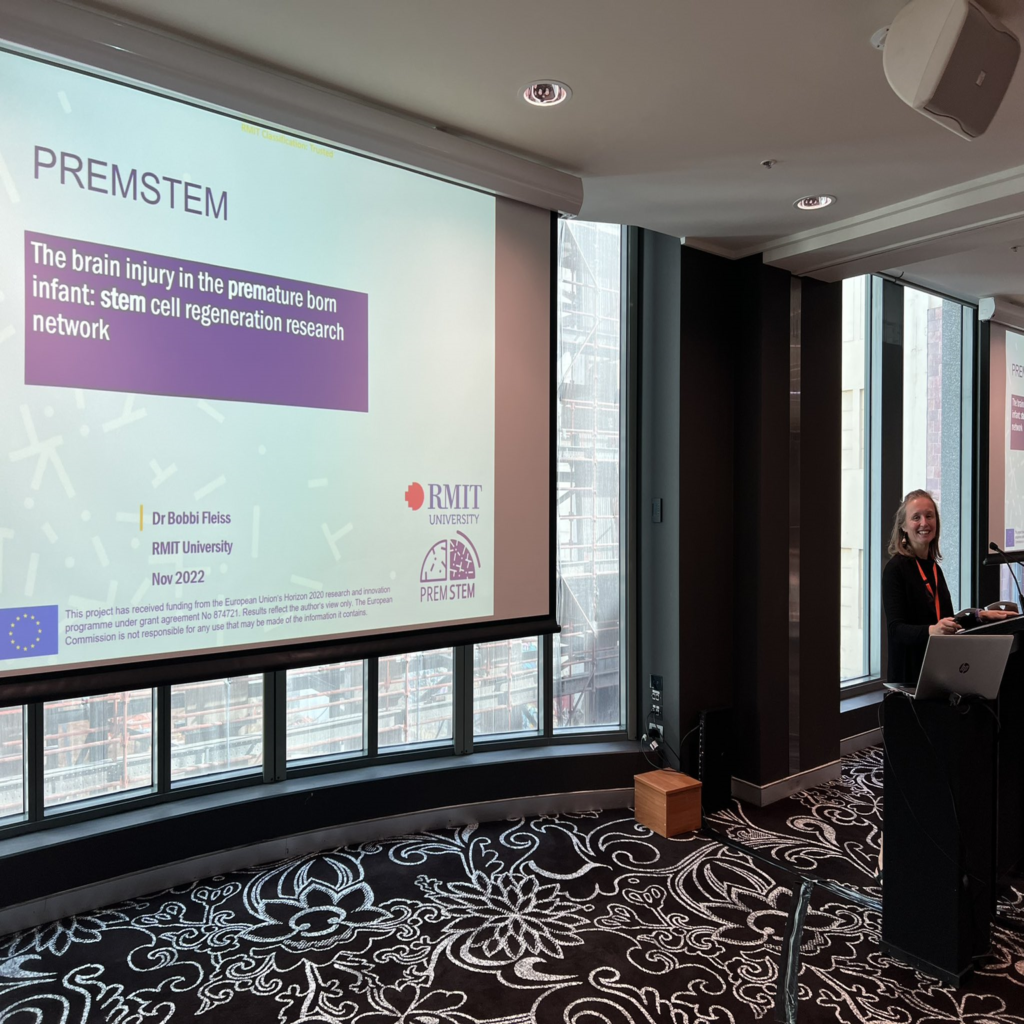As we approach the end of the year, I’d like to take the opportunity once more to summarise some of the key activities in the project. One of my 2022 highlights was being able to come together as a consortium for our annual meeting in Utrecht. Personally, it was great to hear the progress we are making and catch up with old friends. A big thank you once again to the UMCU team for making us so welcome!
Scientific progress
Our research team at the University of Gothenburg has been working hard this year to complete the experiments in the small animal model and complete the data needed to select the top options to test in the large animal model.
The ranking of the Gothenburg findings and data already collected from Inserm showed the best results came in experiments where we tested a delayed intranasal administration of the stem cells. In these experiments, the stem cells had a positive effect in both the model of germinal matrix hemorrhage and inflammation-induced brain injury. In the latter we saw an improvement in the expression of myelin proteins.
We’ll test the best ranked options from the small animal model in the large animal model at the University of Maastricht. Besides testing the administration, timing and dosage options of the stem cells, this team has been conducting experiments with nanoparticles to see where the stem cells end up in the body. They’ve also been observing long-term outcomes of perinatal brain injury in preterm-born sheep.
2022 peer-reviewed publications
| Targeting microbial metabolites to treat autism Nature Medicine | Author(s): Rochellys Diaz Heijtz, Pierre Gressens, Jonathan R. Swann |
| Induction of mitochondrial fragmentation and mitophagy after neonatal hypoxia–ischemia Cells | Author(s): Syam Nair, Anna-Lena Leverin, Eridan Rocha-Ferreira, Kristina S. Sobotka, Claire Thornton, Carina Mallard, Henrik Hagberg |
| The impact of mouse preterm birth induction by RU-486 on microglial activation and subsequent hypomyelination International Journal of Molecular Sciences | Author(s): Cécile Morin, David Guenoun, Irvin Sautet, Valérie Faivre, Zsolt Csaba, Leslie Schwendimann, Pierrette Young-Ten, Juliette Van Steenwinckel, Pierre Gressens, Cindy Bokobza |
| A unique cerebellar pattern of microglia activation in a mouse model of encephalopathy of prematurity GLIA | Author(s): Luisa Klein, Juliette Van Steenwinckel, Bobbi Fleiss, Till Scheuer, Christoph Bührer, Valerie Faivre, Sophie Lemoine, Corinne Blugeon, Leslie Schwendimann, Zsolt Csaba, Cindy Bokobza, Dulcie A. Vousden, Jason P. Lerch, Anthony C. Vernon, Pierre Gressens, Thomas Schmitz |
| Magnetic isolation of microglial cells from neonate mouse for primary cell cultures Journal of Visualized Experiments | Author(s): Cindy Bokobza, Alice Jacquens, Manuela Zinni, Valérie Faivre, Jennifer Hua, David Guenoun, Caroline Userovici, Shyamala Mani, Vincent Degos, Pierre Gressens, Juliette Van Steenwinckel |
| The multiple faces of extracellular vesicles released by microglia: where are we 10 years after? Frontiers in Cellular Neuroscience | Author(s): Martina Gabrielli, Stefano Raffaele, Marta Fumagalli, Claudia Verderio |
| Targeting the brain 5-ht7 receptor to prevent hypomyelination in a rodent model of perinatal white matter injuries Journal of Neural Transmission | Author(s): Cindy Bokobza, Alice Jacquens, David Guenoun, Blandine Bianco, Anne Galland, Maxime Pispisa, Alexandra Cruz, Manuela Zinni, Valérie Faivre, Anne Roumier, Sophie Lebon, Tania Vitalis, Zsolt Csaba, Tifenn Le Charpentier, Leslie Schwendimann, Pierrette Young-Ten, Vincent Degos, Patricia Monteiro, Pascal Dournaud, Pierre Gressens, Juliette Van Steenwinckel |
Annual meeting
Around 30 of our team attended the all-day presentations on 8 September in person with other partners and members of our ethics and innovation management advisory boards joining us online. Each work package team presented on the progress made this year which are summarised above. The day before, some of our postdocs and PhD candidates met to present current work – a great afternoon for strengthening bonds and practising presentation skills in a friendly environment.


Science dissemination

In the project we aim not only to do the basic science but to tell people about it, which is the responsibility of all our partners who do so when speaking at conferences and events.
Megan Finch-Edmondson highlighted PREMSTEM’s Patient/Consumer Advisory Board as an exemplar of a working group/advisory committee specific to a research project at AusACPDM in February.
Ezgi Şengün (pictured) presented her poster at the NVVI Annual Winter School in May. Ezgi is a PhD candidate in the Radboudumc research team which is assessing the immunosuppressive capacity of mesenchymal stem cells from umbilical cord tissue (UC-MSCs) on both innate and adaptive immune cells.

In June, Flora Faure and Solène Ruinet presented posters at fUSBrain2022. Flora and Solène are PhD candidates at Physics for Medicine Paris (INSERM U1273). Flora’s poster included data from the Inserm lab which came from the same neuroinflammation model we’re using in PREMSTEM.
Solène’s poster, entitled ‘Ultrasound multiparametric imaging of neuroinflammation’, partially related to her PREMSTEM research. It presented several methods to characterise neuroinflammation using ultrasound imaging, as well as some preliminary results on the impact of LPS inflammation on neurovascular coupling.
As per the image to the left, I presented current research into stem cells as a therapeutic intervention to influence preterm brain development at the EAPS Congress in October.


Martina Gabrielli presented a poster at the BraYn conference in September. The poster described the role of extracellular vesicles released by microglia in the propagation of synaptic dysfunction in Alzheimer’s disease. The team at IN-CNR is now connecting this research on Alzheimer’s with PREMSTEM’s core topics.
Bobbi Fleiss presented at the 2022 Neonatal Cell Therapies Symposium in November with her talk ‘Mesenchymal stromal cells for preterm brain injury: PREMSTEM project’. She described data gathered by the Inserm and University of Gothenburg teams on the dose and administration of the stem cells in the small animal models.
Engaging our stakeholders through co-creation


This year we started our co-creation activities and invited external stakeholders to get involved in the project. Our five workshops so far have been attended by parents of preterm children, representatives of advocacy groups, health professionals, researchers and more. The discussions are helping us to refine our communication and exploitation strategies and we’ll continue with more workshops and interviews in the new year.
Communicating our research
Our team regularly promotes our work on social media and this year we’ve added new information to our website and resources, including an animation about stem cells, fact sheets and summaries of some of our scientific publications.
Awards and nominations
I was elected as a member of the French Academy of Medicine in September.

Thank you to all of our partners, Patient/Consumer Advisory Board members, ethics and innovation management advisory board members, co-creation facilitator and participants, and everyone else who has taken an interest in the project. It has been a very good year and I can’t wait to continue this excellent team effort in 2023.
Pierre Gressens
Project Coordinator
Inserm






